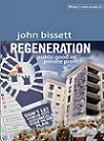Regeneration: Public Good or Private Profit?

Written by Dr. John Bissett, a key member of the St. Michael's Estate Community Regeneration Team, 'Regeneration: public good or private profit?' puts the Public Private Partnership model - which collapsed so spectacularly in the summer of 2008 - under a critical microscope.
Dr. Bissett's book - published in January 2009 by TASC/New Island - not only chronicles the experiences of one community fighting for the regeneration of their estate: it also traces the changing nature of the relationship between Dublin City Council and its tenants, and offers a brief history of the urban redevelopment approaches adopted in Dublin.
Above all, however, this is the story of St. Michael's Estate in Inchicore, and the ten-year battle waged by residents trying to secure decent housing for themselves and their families amidst the greatest prosperity Ireland has ever seen. In May 2008, the dying days of the Celtic Tiger saw the residents' hopes for the future dashed for a third time, as Dublin City Council announced that the Public Private Partnership between the City Council and McNamara/Castlethorn would not proceed.
The PPP collapse marked the end of the most recent phase in a story which began in the late 1990s when Dublin City Council (formerly Dublin Corporation) started work on a regeneration plan for its inner city social housing complexes. It consulted with residents and community bodies to establish the type of regeneration needed in each area. The residents of St. Michael's Estate opted overwhelmingly for 'houses with gardens' to replace the blocks of flats on their Estate. The type and size of community facilities needed to support the residents on the new Estate were also agreed, and in 2003 Dublin City Council submitted a plan to An Bord Pleanala for decision.
The Department of the Environment vetoed the plan on cost grounds, advising the Council that the way to deliver social housing in St. Michael's and elsewhere was a "Public/Private Partnership" arrangement with a private developer. The principle behind the market-driven PPP model is simple: the State would trade its land in return for the building of a set number of social and affordable housing units and community facilities by a developer (McNamara/Castlethorn) on the site. In return, the developer would be allowed to build a set number of private residential units and retail facilities which they could sell or let on the open market. The PPP conditions for St. Michael's also encouraged developers to make a 'cash offer' to the State, in addition to building the agreed social housing and facilities.
The net effect of this decision was to substantially increase the proposed housing density in each area in order to maximise the profit from the sale of private housing units, since this would be required to fund the projects.
Residents from many of the complexes, and in particular St. Michael's Estate, resisted this development but were eventually constrained to agree to new high density plans with minimum provision for 'houses with gardens'. The vast majority of the original flats had already been demolished and it was hoped construction would start in 2008.
However, the market-led nature of the PPP model rendered the entire regeneration of St. Michael's Estate dependent on housing market projections. Each PPP project is contingent on prevailing economic conditions. As the recession unfolded, it became apparent that McNamara/Castlethorn would be unable to reap the anticipated profits from the private element of the scheme, and would therefore not proceed with the project.
Ironically, the residents of St. Michael's thus fell victim to the end of a property boom in which they had never participated.
St. Michael's Estate, together with a growing number of other City Council flat complexes, bore the brunt of what Bissett describes as the Council's shift towards an 'entrepreneurial' ideology. The entrepreneurial ideology involves the stripping down, privatisation and - in many cases - sale of State assets and services, not only in housing but also in sectors such as health and education.
As well as examining the changing City Council approach to regeneration, Bissett analyses the power structures governing the relationship between the State and local communities - a power structure with which residents of St. Michael's became very familiar as they struggled to assert a democratic and egalitarian model of regeneration in the face of the market-driven considerations underlying the PPP process.